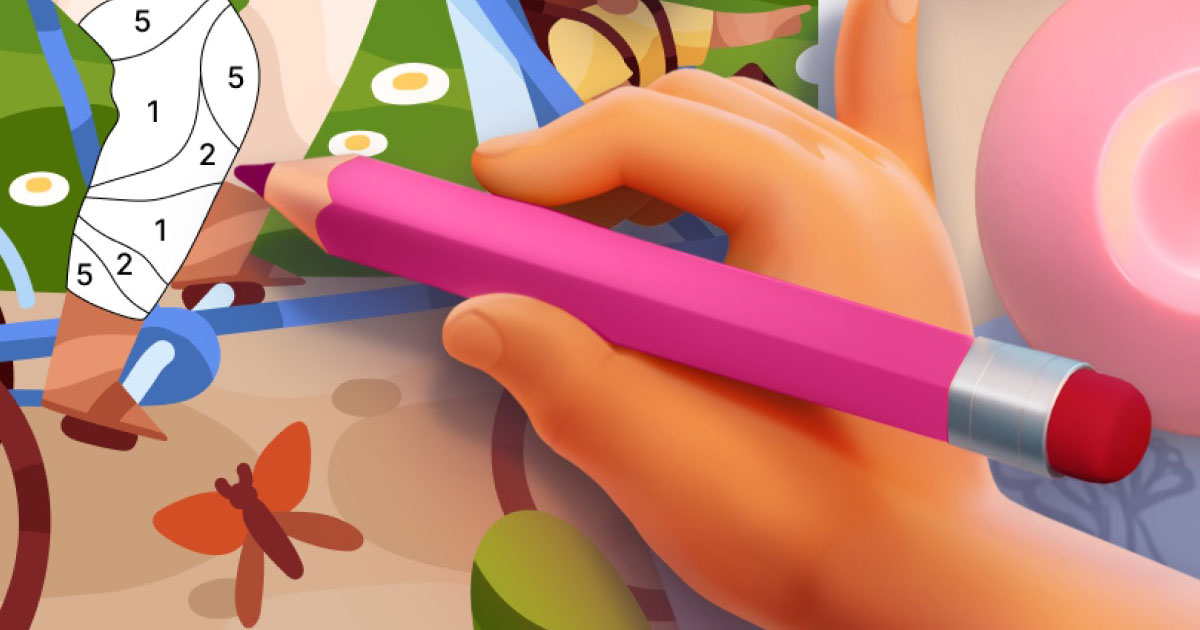Round Table: The Situation in the Coloring Games Market
The mobile game genre "coloring by numbers" (coloring, paint by number) is rarely written or talked about. However, games in this genre consistently generate around 30 million downloads a month. What's happening in this niche, and is it worth entering it? We talked with Beresnev Games, ZiMAD, and Belka Games.
1. What's currently happening in the genre? It seems like not much has changed in the past five years. The total downloads of the top 10 games in the genre have plateaued at 16-18 million monthly downloads and remain there.
Oleg Beresnev — owner and CPO of Beresnev Games
The genre has indeed stabilized. The genre has reached its peak in audience acquisition, and I believe the audience growth potential has been exhausted.
Anastasiya Pavlyuchenko — Lead Marketing Manager at ZiMAD
Installations within the genre aren't growing. You could say the genre is stagnating. Over the past years, there hasn't been much change among the leaders of classic number coloring and pixel coloring games, and new games rarely break into the top unless they bring something new to the genre. This leads to copying general approaches to creatives, landing page graphics, and mimicking genre leaders.
Besides classic colorings, there are also colorings with a décor meta and dramatic narrative colorings. However, their audience is much smaller compared to the classics.
New apps are emerging among classic paintings that differentiate from competitors through different positioning.
For example, Vita Color for Seniors presents itself as a puzzle for the elderly, adapted for people with vision issues, featuring enlarged UI elements.
Another example is Zen Color, positioned as a relaxation coloring book. Its creatives emphasize this, using meditative images in marketing campaigns. This approach is successful. Although Zen Color was released in 2021, its audience is growing. As of early 2024, the number of installs in the US exceeds that of Happy Color.
Downloads of leading US games in the genre
2. How strong is the competition in this niche? And what is happening with the traffic cost in it?
Oleg Beresnev — owner and CPO of Beresnev Games
Competition is quite intense, especially challenging to compete with coloring games that have a large volume of an existing audience. Some players have long established themselves in this genre, with significant resources for scaling and promotion.
Creating a competitive position in this segment for new games is very challenging. Due to strong competition, the cost of traffic when attracting through gameplay creatives can be quite high. It is essential to have a traffic payback strategy, excellent long-term retention rates, and a well-balanced IAP/advertisement monetization strategy.
Anastasiya Pavlyuchenko — Lead Marketing Manager at ZiMAD
Competition is strong, but regarding advertising, it's not one game monopolizing the traffic. Both genre leaders and fresher products appear among the top creatives. Traffic costs are rising, as with other genres. Based on data from open sources, CPI in the US on Android starts at $1.2. Smaller volumes can fetch installs at this cost, but prices significantly increase with scaling.
3. During the peak popularity of the genre (in 2018-2019), top projects earned from IAP as well. Now, analytical services suggest things have changed. How do such apps monetize?
Oleg Beresnev — owner and CPO of Beresnev Games
Ad monetization plays the primary role. Along with good long-term retention, games repay through ads. IAP monetization is based on customization, unique offers, and a variety of gaming experiences, but not on losses, which significantly complicates monetization and game design where the core mechanic is coloring.
Anastasiya Pavlyuchenko — Lead Marketing Manager at ZiMAD
Indeed, until 2020, there were projects that profited from IAP, mainly pixel coloring. Then came a flood of new competitors, shifting the market to a predominantly ad-based monetization model.
Purchases and subscriptions remain part of the revenue, but in modern coloring apps, most content is either completely free or accessible through in-game currency.
At one point, a coloring app with a décor meta (offering more room for IAP monetization) was at the top in IAP revenues, but in the past two years, its revenues have reached the level of classic coloring apps. Currently, the top IAP revenue earners are projects offering subscription options.
Revenue of leading US games
Pavel Sudakov — Head of R&D at Belka Games
During the peak years, IAP earnings were episodic. Major projects had one main IAP – to disable ads. They earned something from it, but it was marginal. Advertising is the driver of monetization in coloring apps.
4. From the outside, it seems like a simple genre, but is it really? How much could it cost to develop a competitive game in the genre?
Oleg Beresnev — owner and CPO of Beresnev Games
Developing a competitive project where coloring is the main mechanic won't be cheap, even if it might seem so at first. Development must consider additional monthly expenses for producing images, offers, and events. Since long-term retention is crucial in these projects, you'll need a vast amount of content and a well-thought-out game flow for at least 360 game days.
Additionally, if a décor meta or similar is added to the coloring, costs could increase by 1.5 to 2 times.
Anastasiya Pavlyuchenko — Lead Marketing Manager at ZiMAD
From an app architecture perspective, coloring apps are simple and relatively inexpensive to develop. This results in very high competition in the market. To maintain a position, the product must be technically optimized flawlessly. Many teams fail at this part, falling far behind the leaders. To start earning significant money, you need highly experienced traffic procurement, monetization, and ASO specialists; otherwise, large-scale acquisitions will not be budget-friendly. The number of companies with such specialists is limited. So it's "simple yet complex."
Pavel Sudakov — Head of R&D at Belka Games
We once thought so too. Since then, we haven't ventured into the coloring genre.
The devil is in the details of coloring by numbers (pardon the pun). The images must be meticulously crafted and meet specific conditions for coloring.
Market leaders supply tens of pages of such content daily. In 2019, our team had 10 artists, and we still partnered with external studios. Even in such conditions, we couldn't meet users' content demands.
Artists in this genre possess specific expertise — it's challenging to switch them to other studio projects if unsuccessful.
Note: Yes, AI wasn't available then. But I doubt it would drastically cut costs. The main challenge with using it remains details.
5. What distinguishes the market leaders in the genre from numerous imitators?
Oleg Beresnev — owner and CPO of Beresnev Games
Very good long-term retention plus a large player base acquired early in the genre's existence.
Anastasiya Pavlyuchenko — Lead Marketing Manager at ZiMAD
The unchanged leader of the genre, Happy Color, distinguishes itself (and attracts new audiences) by leveraging content from major IPs (such as Disney and Marvel), collaborations, unique content tied to global events, and philanthropy. The game also boasts a large community, within which various activities related to in-app content are regularly conducted.
Summing up, a good project's recipe is abundant free and diverse content (different drawing styles, unique images, collaboration with creators, promotional storytelling, etc.), UI convenience, and the absence of aggressive advertising.
It’s also noteworthy that coloring apps as a genre have evolved dynamically in terms of content (featuring animated images, glitter images, segmented images, etc.). Coloring books have introduced a wide variety of categories and content classifications. Primarily, it's a content-driven game where you can stand out by offering new experiences, whether it's a game mode, image style, or player motivation.
Pavel Sudakov — Head of R&D at Belka Games
We've concluded that market leaders excel primarily due to their mastery in acquiring traffic cost-effectively and holding vast amounts of content. Maybe we're mistaken in these conclusions, but we won't return to the niche without adhering to these two points. The products themselves lack any irreplaceable know-how. Perhaps it’s unnecessary.
Main question: Is it worth entering the niche now?
Oleg Beresnev — owner and CPO of Beresnev Games
I wouldn't recommend it without the following:
- Experience in similar games, essential for understanding the genre's weaknesses in user monetization;
- Well-organized and optimized processes for creating a large number of artworks;
- Understanding how you will reduce the user acquisition cost for your coloring app since current genre giants have maximized the potential of gameplay creatives.
Anastasiya Pavlyuchenko — Lead Marketing Manager at ZiMAD
If you understand how to stand out from other coloring apps effectively, promote the game at a low cost, and ensure high technical quality.
The mechanic is undoubtedly not "dying" nor fading away soon; it has a substantial audience, and the genre's retention metrics (stickiness, DAU, RR) are stable. However, like all genres, coloring books might be heading towards hybridization.
Currently, hyper-casual projects related to coloring (Color Match, Drawing Carnival, Color Page ASMR) dominate the top of adjacent genres. Perhaps it's worth looking into such projects and adding a bit of "fun" to classic coloring apps with these mini-mechanics.
Pavel Sudakov — Head of R&D at Belka Games
In my opinion, both now and previously, there have been and continue to be more interesting niches. I wouldn’t recommend.





